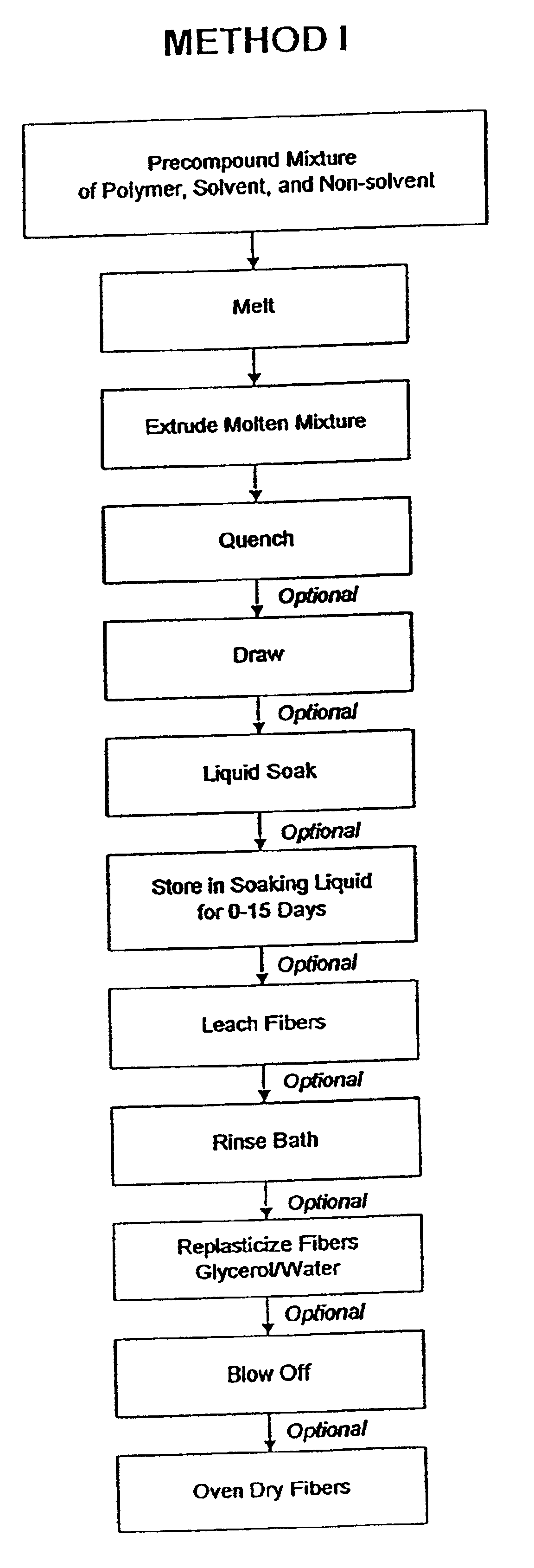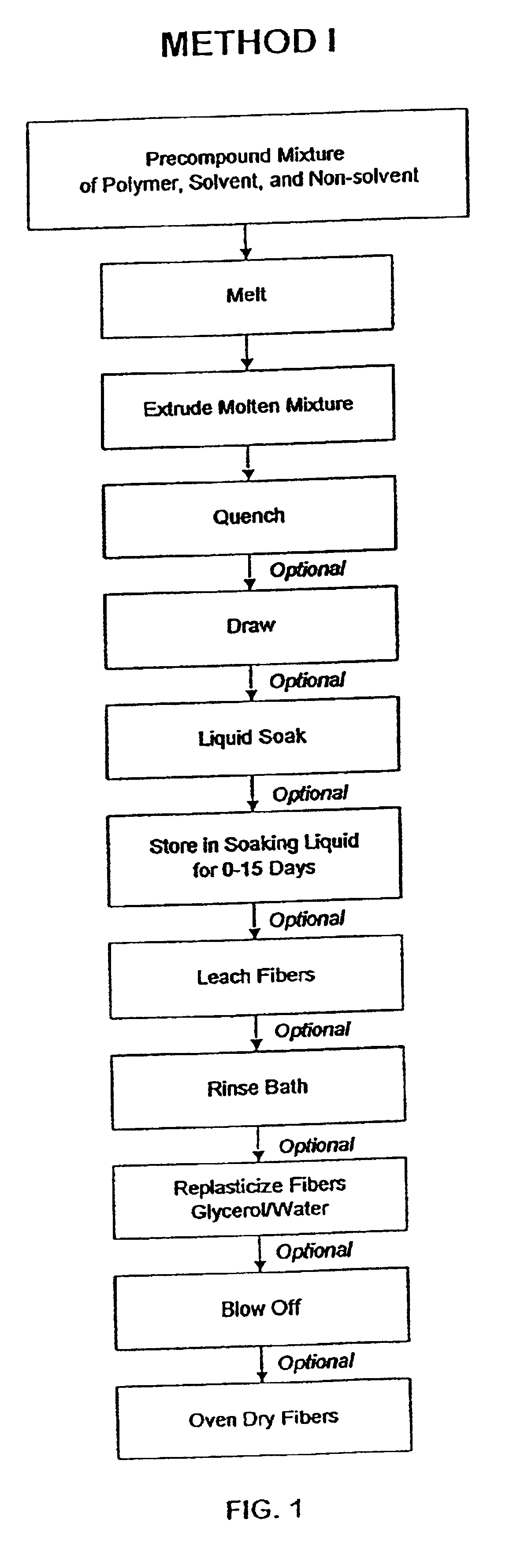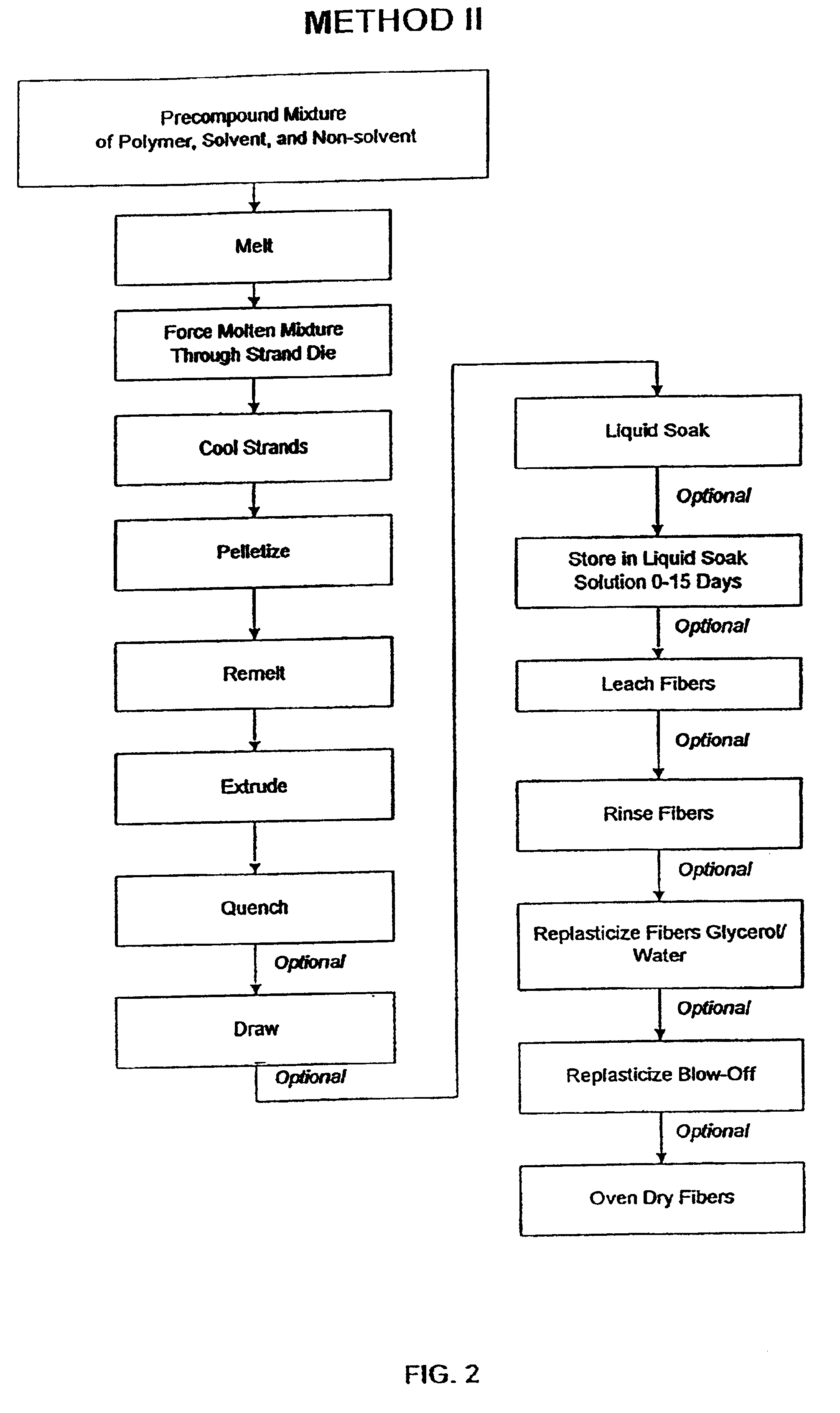Melt-spun polysulfone semipermeable membranes and methods for making the same
a technology of polysulfone and semi-permeable membranes, which is applied in the direction of membranes, filtration separation, separation processes, etc., can solve the problems of hazardous waste disposal, difficult removal of core liquid used to form fiber lumens, and inacceptable contamination of fluids treated using membranes
- Summary
- Abstract
- Description
- Claims
- Application Information
AI Technical Summary
Benefits of technology
Problems solved by technology
Method used
Image
Examples
example 1
[0054]A composition was prepared comprising about 36 weight percent Udel P1835NT11, a brand of bisphenol A polysulfone (available from Amoco Polymers, Inc. of Alpharetta, Ga.) about 44.3 weight percent anhydrous sulfolane (available from Phillips Chemical Company of Borger, Tex.) and about 17.7 weight percent poly(ethylene glycol) having an average molecular weight of about 1000 daltons (available from Dow Chemical Company of Midland, Mich.). The solvent to non-solvent ratio was about 4.5:1. The composition was compounded in a co-rotating twin-screw extruder at about 132° C. The extruded composition was cooled, pelletized using an RCP 2.0 pelletizer (available from Randcastle Extrusion Systems, Inc., of Cedar Grove, N.J.), and then remelted and extruded through a 30-hole hollow-fiber spinneret at about 149° C. using a single-screw extruder. The resulting hollow-fiber extrudate was quenched in air at about 21° C. for about 15 seconds, drawn from a first godet (rotating at a surface s...
example 2
[0058]A composition was prepared comprising about 36 weight percent Udel P1835NT11 polysulfone (Amoco Polymers, Inc.), about 45.7 weight percent anhydrous sulfolane (Phillips Chemical), and about 18.3 weight percent poly(ethylene glycol) having an average molecular weight of about 1000 daltons (Dow Chemical), yielding a solvent to non-solvent ratio about 2.5:1. The composition was compounded in a co-rotating, twin-screw extruder at about 173° C. The extruded composition was then pelletized, remelted, and extruded through a 30-hole hollow-fiber spinneret at about 178° C. using a single-screw extruder. The resulting hollow-fiber extrudate was quenched in air at about 22° C. for 7-8 seconds. The resulting hollow-fiber membrane was wound on a core at about 110 feet per minute, and held dry for about one hour. The hollow fiber was then placed in a water bath maintained at a temperature of about 25° C. for a period of about 12-15 hours.
[0059]The hollow fiber was then processed by unwindin...
example 3
[0061]A composition was prepared comprising about 38 weight percent Udel P1835NT11 polysulfone (Amoco Polymers, Inc.), about 44.3 weight percent anhydrous sulfolane (Phillips Chemical), and about 17.7 weight percent poly(ethylene glycol) having an average molecular weight of about 1000 daltons (Dow Chemical), yielding a solvent to non-solvent ratio of about 4.5:1. The composition was compounded in a co-rotating, twin-screw extruder at about 99° C., and extruded directly through a 30-hole hollow-fiber spinneret. The extrudate was quenched in air at about 26° C. for about 6 seconds. The resulting hollow-fiber membrane was wound on a core at about 160 feet per minute, and placed immediately into a water bath for a period of about 12-15 hours.
[0062]The hollow fiber was then unwound from the core at about 30 ft / min and passed through a 37° C. water leach bath for about 40 seconds. The fiber was then immersed in a room-temperature water rinse bath for about 140 seconds. The fiber was repl...
PUM
| Property | Measurement | Unit |
|---|---|---|
| Percent by mass | aaaaa | aaaaa |
| Percent by mass | aaaaa | aaaaa |
| Percent by mass | aaaaa | aaaaa |
Abstract
Description
Claims
Application Information
 Login to View More
Login to View More - R&D
- Intellectual Property
- Life Sciences
- Materials
- Tech Scout
- Unparalleled Data Quality
- Higher Quality Content
- 60% Fewer Hallucinations
Browse by: Latest US Patents, China's latest patents, Technical Efficacy Thesaurus, Application Domain, Technology Topic, Popular Technical Reports.
© 2025 PatSnap. All rights reserved.Legal|Privacy policy|Modern Slavery Act Transparency Statement|Sitemap|About US| Contact US: help@patsnap.com



